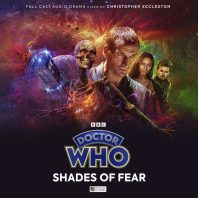
Released February 2023
SOME SPOILERS FOLLOW
Alien threats come in any number of different forms and colours, and when West Morebry residents start to notice disappearances around a local charity shop, the Doctor finds himself battling against the colour red in Lizzie Hopley’s ‘The Colour of Terror.’
Admittedly, an alien that can use and exploit a colour of the visible spectrum is truly fascinating, and the notion that something as natural as a sunset can provide the means of global conquest is frightening in both its simplicity and raw power. Indeed, the contrast to the smaller moments of ketchup bottles exploding, a fire truck catching fire, and a ginger cat speaking works extremely well as these aliens look to spread their influence into the outside world and beyond, and the visuals and sheer potential they possess compensate for a somewhat murky methodology about just how they can take the smallest bit of even superficial red to assert control over living beings and wreak such havoc, a fact brought to the fore so prominently as the charity shop owner fully submits to the power of red. Of course, the colour red has long been associated with feelings of anger and rage, and so on one hand it’s only natural that the aliens should seemingly want nothing more than the conquer the planet and all of creation as they use such an intense wavelength to exert their influence, but it would have been more satisfying to allow more communication between the Doctor and these creatures to learn more about their origins and to give even a little deeper context to their actions. It’s certainly possible that this advance scouting party or other factions of these aliens may again focus in the future, but there’s little depth provided to these aliens beyond the strong visual component they present.
Interestingly, ‘The Colour of Terror’ is much more of an ensemble piece than most stories in The Ninth Doctor Adventures, and although there isn’t quite enough time for everyone involved to fully develop, there very much is a sense of camaraderie, support, and dedication that makes this cast feel almost like an established TARDIS team. With the exception of Mrs Bevell who comes off as brash and unlikable even before her red-driven turn given her obsession with her shop’s online rating and her petty feud with the neighbours next door, the denizens of West Morebry are compelling and rife with palpable emotions. This is perhaps best exemplified by Pete who is so open about his own thoughts and experiences and to the wonders the Doctor presents, and Frank Skinner beautifully imbues a soft compassion to the role that highlights some of the best humanity has to offer. Likewise, George Naylor is brilliant as Robbie who is trying to atone for his previous transgressions, and the scene in which he finally opens up to the Doctor only to find that he does not have to be defined by those earlier actions is easily a highlight that also emphasizes the best of the Doctor. With Dinita Gohil and Laura Rollins delving into love and loss exceedingly well in the brief time allotted as well, ‘The Colour of Terror’ is at its strongest when these supporting characters are allowed to star alongside the always-charismatic Christopher Eccleston whose determined Doctor finds himself wholly challenged by the very unique threat before him and opening up to and connecting with those around him much more than usual, changing and being changed equally effectively.
This is a story big on ideas and ambition despite its relatively intimate scale, but the central Mrs Bevell never develops as a true character beyond broad strokes of selfishness and there is too much left unexplained to truly capitalize on the unique alien threat. Still, the brilliant performances, visuals, and direction combine to make for a nonetheless engaging experience overall that just about overcomes some of its other shortcomings.
- Release Date: 2/2023
- Directed by: Helen Goldwyn
- Written by: Lizzie Hopley


Leave a Reply